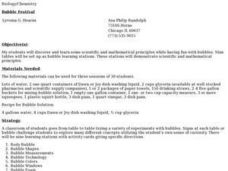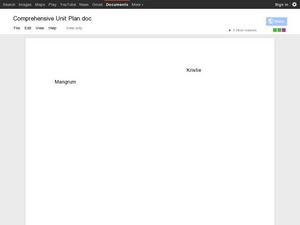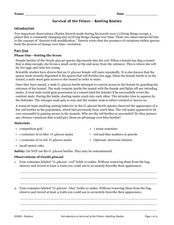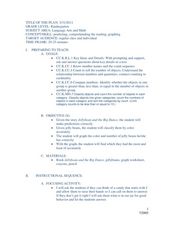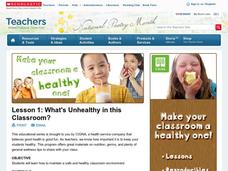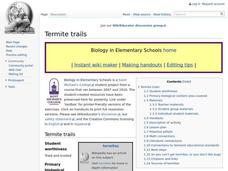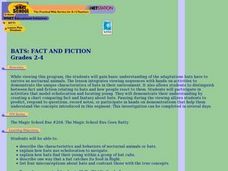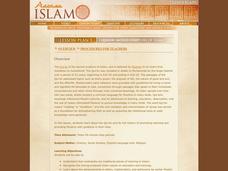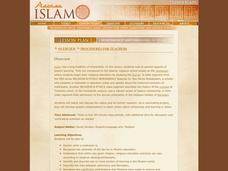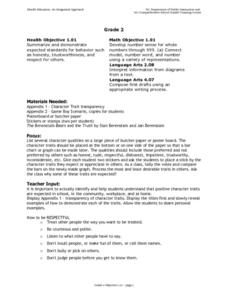Curated OER
Kindergarten Exploration Tubs
Students identify their names as a symbol for themselves. They describe characteristics of organisms. They utilize tools to gather data and compare size.
Curated OER
Terror in Space
Students view a video clip about the role of satellites in space. They examine the concept of center of mass. They participate in an experiment showing how altering the location of an object's center of mass can change its motion.
Curated OER
Spaghetti Graphs
Young scholars work in pairs to test the strength of spaghetti strands. They collect and graph data to determine a line of best fit. Students create a linear equation to interpret their data. Based on the data collected, young scholars...
Curated OER
Bubble Festival
Students practice scientific inquiry while learning about bubbles. In this instructional activity about bubbles, students explore characteristics of bubbles. Students move through nine different "bubble" stations following directions and...
Curated OER
Ant Farm
Learners explore the value of insects in the natural world. In this insect lesson, students examine species of insects, collect and record data, and analyze the data.
Curated OER
Clip the Face
Middle schoolers discover the moon's phases and the rarity of eclipses. In this lunar lesson, students view a video titled Spin Around the Solar System: A Moon Dance, which demonstrates the key differences between a lunar and solar...
Curated OER
Infusing Equity Vs Gender into the Classroom
Students explore the effect of gender bias in the classroom. In this statistics lesson, students discuss the effects of stereotyping, discrimination, and gender bias in the classroom. They collect data on different work places dealing...
Curated OER
The Life Cycle of the Mealworm
Fourth graders provide a habitat for live mealworms and observe their life cycle. In this animal life cycle and scientific inquiry lesson, 4th graders create a habitat for a live mealworm and observe and record related data as it grows....
Curated OER
Is the Hudson River Too Salty to Drink?
Students explore reasons for varied salinity in bodies of water. In this geographical inquiry lesson plan, students use a variety of visual and written information including maps, data tables, and graphs, to form a hypothesis as to why...
Curated OER
Survival of the Fittest -- Battling Beetles
Students experiment with traits. In this Science lesson, students test the strength of beetles using M&M candies in lieu of the insects. Students use the Hardy-Weinberg Equation to calculate possible offspring traits of further...
Curated OER
Multiplying Decimal Numbers: Using Zeros as Placeholders
Explore decimals with upper graders. They solve problems from their textbook involving decimal multiplication. Afterward, as a class, they check their answers by comparing them to those projected with an overhead projector.
Curated OER
The Jellybeans and the Big Dance
Enchant your youngsters by reading them The Jellybeans and the Big Dance, by Laura Numeroff and Nate Evans. Ask them to name objects that begin with the letter J like jellybeans. Give each of them some jellybeans to sort by color....
Curated OER
Manatee Endangered
High schoolers (or middle schoolers) research the endangered manatee and the Endangered Species Act. They choose a local animal that is threatened or endangered and attempt to find out what is being done to protect it. Short, but sweet,...
Curated OER
Buddy, Are You Ready?-Preparing for School Emergencies
Students explore natural disasters by reading stories about volcanoes, earthquakes, floods, and hurricanes. They explore safe behaviors in order to understand what to expect in a catastrophe. Students practice safe evacuation procedures...
Curated OER
Lesson 1: What's Unhealthy in this Classroom?
Students discover behaviors and practices that are unhealthy within their classroom environment. In this early childhood lesson plan, students identify behaviors and practices that lead to an unhealthy environment, and discuss how to...
Curated OER
Termite Trails
Young scholars observe termite trail-following behavior. In this termite trails lesson, students draw a circle or other shape approximately eight inches across with a ball point pen. Teacher taps out termites into the circle...
Curated OER
Incident
Students gain insight into human behavior from the study of literature. They read a poem and respond by creating a poem of their own. After a lecture/demo, students utilize a worksheet imbedded in this plan to help them compose an...
Curated OER
Bats: Fact and Fiction
Students describe the characteristics and behaviors of bats. After viewing a video, they explain how bats use echolocation to navigate and how they find their young within a group. They list four misconceptions about the animal and...
Curated OER
Qur'an: Sacred Scripture of Islam
Students discover the strong emphasis Islam puts on education. Using the Internet, they identify advancements in ethics, math and astronomy. They explain the importance of madrasahs, or traditional places of learning in Islam, and...
Curated OER
Scholarship and Learning in Islam
Students explain what a madrasah represents in Islam. Using the Muslim world as an example, they identify and describe two or more centers of learning. They explain the contributions that Muslims have made to science and math and...
Curated OER
Health Education: Earning Respect
Second graders explore how to earn respect. In this health lesson plan, 2nd graders summarize and demonstrate expected standards for behavior such as honesty, trustworthiness, and respect for others.
Curated OER
Value: Love, Topic: Friendship
Sixth graders participate in a skit, "Henry Gets it Right." They discuss the skit and qualities of a friend. They discuss an example of a wild animal taking care of animals of a different species. They consider the behavior versus the...
Curated OER
Reflections Of
Students create angles using mirrors. In this angle reflection lesson, students draw angles, then use mirrors to create angles using reflections and measure the new angles.
Curated OER
Iterating Linear Functions
Young scholars use a spreadsheet to investigate data. In this algebra lesson, students collect and graph data on a coordinate plane. They explain properties of a linear equation both algebraically and orally.



